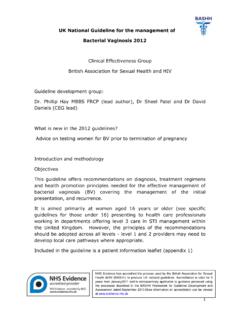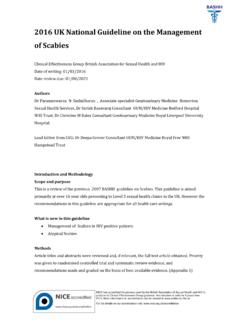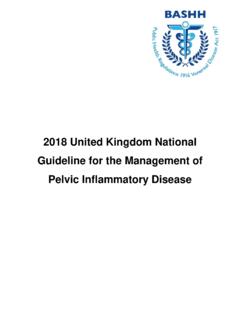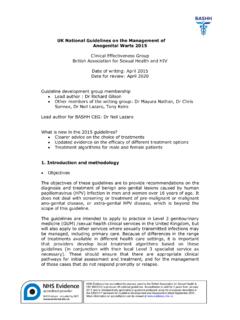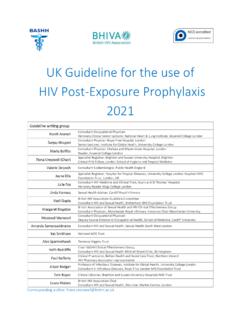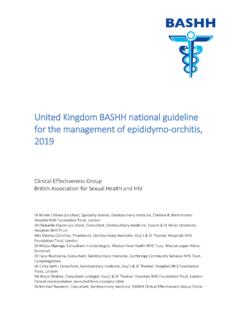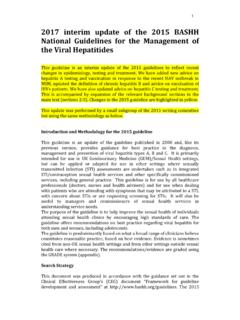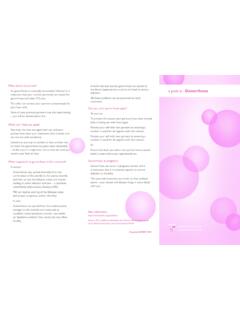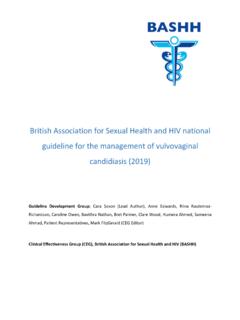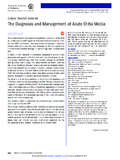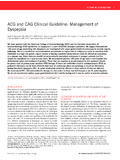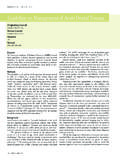Transcription of 2018 BASHH UK national guideline for the …
1 1 2018 BASHH UK national guideline for the 1 management of infection with Mycoplasma genitalium 2 3 Suneeta Soni, Paddy Horner, Michael Rayment, Nicolas Pinto-Sander, Nadia Naous, Andy Parkhouse, 4 Darren Bancroft, Carl Patterson, Helen Fifer 5 6 7 8 Introduction 9 This is the first British Association of Sexual Health and HIV ( BASHH ) guideline for the diagnosis and 10 management of Mycoplasma genitalium in people aged 16 years and older. The guideline is primarily 11 aimed at level 3 sexually transmitted infection (STI) management services within the UK although it could 12 also serve as a reference guide for STI services at other levels. 13 Whilst the guideline sets out recommendations for best practice according to current evidence, it is 14 acknowledged that not all clinics will have access to M. genitalium testing at the time of guideline 15 publication. The objective of this guideline is therefore also to assist clinics and laboratories in 16 making the case for funding towards M.
2 Genitalium testing by underlining the importance of testing 17 in relevant populations. 18 19 Editorial independence 20 This guideline was commissioned and edited by the Clinical Effectiveness Group (CEG) of BASHH , 21 which also provided funding for a literature search. No other or external funding was obtained. 22 23 24 Conflict of interest 25 All authors have signed BASHH CEG CoI forms. PH is partially funded by the national Institute for 26 Health Research Health Protection Research Unit (NIHR HPRU) in Evaluation of Interventions at the 27 University of Bristol. HF is employed by Public Health England (PHE); PHE offers Mycoplasma 28 2 genitalium testing for a fee, and has received remuneration for contract research of diagnostic 1 assays and consultancy work. None of the other authors have any declarations. The views expressed 2 by the authors are not necessarily those of the NHS, the NIHR, PHE or the Department of Health.
3 3 4 Rigour of development 5 This guideline was produced according to specifications made in the CEG s document 2015 6 Framework for guideline development and assessment accessible at 7 8 9 10 Search strategy 11 The writing group determined PICO (Patient, Intervention, Comparison, Outcome) questions which 12 formed the basis for the literature search, and are listed in Appendix 1. 13 A search was conducted using Medline, Embase, the Cochrane library and NHS Evidence. The search 14 heading was kept broad ( genitalium ) to include all the guideline questions. Only publications in the 15 English language were considered. Age, country and study design limits were included in the PICO 16 criteria, except that studies from Japan were considered for questions 8, 9 and 10 because it was felt 17 that evidence in these studies, particularly with respect to resistance and treatment issues, would 18 contribute significantly to and inform the guideline .
4 (see Appendix 1) . Grey literature included 19 conference abstracts from IUSTI, BASHH , BHIVA, ICAAC, ASHM, ECCMID in last 3 years. The writing 20 group used a modified GRADE system for assessing evidence and formulate recommendations. 21 22 23 Equality impact assessment to be completed after first consultation 24 25 26 27 Stakeholder involvement, piloting and feedback. 28 The draft guideline recommendations were presented at the joint British HIV Association and BASHH 29 annual conference 2018. The draft guideline was appraised by the CEG using the AGREE instrument, 30 posted on the BASHH website for a consultation period of 3 months and piloted in a sample of 31 clinics. In response to the consultation, suitable amendments were made to the guideline and the 32 3 final draft was submitted to the CEG. (appendix XX to be added post-consultation). The patient 1 information leaflet (PIL) was reviewed by the CEG, BASHH patient and public panel and also piloted 2 in a sample of clinics and comments were reviewed and incorporated where appropriate.
5 3 The writing group consisted of genitourinary medicine physicians with experience in managing 4 Mycoplasma genitalium (SS, MR, NPS, PH), a consultant microbiologist (HF), a pharmacist (NN), a 5 sexual health advisor (AP) and two patient representatives (DB, CP). 6 The guideline will be updated every 5 years according to the BASHH CEG guideline framework. This 7 interval could be shorter should new data arise which could significantly impact recommendations. 8 9 Patient and Public Involvement 10 Two patient representatives attended a writing group meeting, contributed to the design and 11 written content of the PIL and commented on the draft guidelines . The guideline was also reviewed 12 by the BASHH Patient and Public 4 Summary of Recommendations 1 Section Recommendation Grading Test for M. genitalium infection in all males with non-gonococcal urethritis 1B Test for M. genitalium infection in all individuals with signs and symptoms suggestive of pelvic inflammatory disease 1B Test current sexual partners of persons infected with M.
6 Genitalium 1D First void urine is the specimen of choice in males 1C Vaginal swabs (clinician- or self-taken) are the specimen choice in females 1C Where possible, all M. genitalium positive specimens should be tested for macrolide resistance mediating mutations 1B Treatment regimens for uncomplicated infection 1. Doxycycline 100mg two times daily for 7 days followed by azithromycin 1g orally as a single dose then 500mg orally once daily for 2 days 2. Moxifloxacin 400mg orally once daily for 10 days 1D 1B Treatment regimens for complicated infection 1. Moxifloxacin 400mg orally once daily for 14 days 1D Alternative treatment regimens 1. Doxycycline 100 mg two times daily for 7 days followed by pristinamycin 1g orally four times daily for 10 days 2. Pristinamycin 1g orally four times daily for 10 days 3. Doxycycline 100mg orally twice daily for 14 days 4. Minocycline 100mg orally twice daily for 14 days 2C 2C 2C 2D All patients should attend for a TOC five weeks (and no sooner than three weeks) after the start of treatment to ensure microbiological cure 1D 2 3 5 Introduction 1 2 1.
7 Microbiology 3 4 Mycoplasma genitalium was first isolated in 1981, having been cultured from urethral specimens of 5 two men presenting with non-gonococcal urethritis (NGU)[1]. M. genitalium belongs to the 6 Mollicutes class [2], and with a genome of only 580 kilobases in size, is the smallest known self-7 replicating bacterium. It lacks a cell wall, and hence is not visible by Gram stain. The organism is 8 fastidious and typically requires weeks or months to culture. 9 M. genitalium has been detected from genito-urinary, rectal and respiratory tract specimens, but 10 carriage in the throat seems to be rare [3]. Although it was initially thought that disease appeared to 11 be limited to the genito-urinary tract, there is some evidence it could potentially cause proctitis.[3-5] 12 The specialised tip-like structure of M. genitalium enables it to adhere to and invade epithelial 13 cells[3].
8 The organism is able to evade the adaptive immune system possibly through both its ability 14 to establish intra-cellular infection and by antigenic and phase variation of its surface-exposed 15 proteins, and infection may persist for months or years[3, 6, 7]. Although the diseases associated 16 with M. genitalium infection are thought largely to be as a result of the host immune response 17 rather than organism-specific features, it has been demonstrated in human fallopian tube organ 18 culture that infection can be directly toxic to cells resulting in cilial damage[4, 7, 8]. 19 20 6 2. Epidemiology 1 2 Prevalence in general population, and risk factors for infection 3 Prevalence estimates for M. genitalium infection in men and women in the general population range 4 from 1 2%, being slightly higher in women[9-11]. Similar to C. trachomatis, risk factors for M. 5 genitalium infection include younger age, non-white ethnicity, smoking, and increasing number of 6 sexual partners[9-11].
9 However, the prevalence of M. genitalium infection appears to peak later 7 than that for C. trachomatis, particularly in men, and to remain higher in older age groups[11-13]. 8 Amongst STI clinic attendees, prevalence ranges are higher, from 4 - 38%[14-16]. 9 10 Sexual transmission 11 In addition to the sexual behavioural risk factors above, sexual transmission is supported by the 12 observation that sexual partners of individuals diagnosed with M. genitalium are more likely to be 13 infected than controls[17-19]. Molecular epidemiological studies also support a sexual transmission 14 model: in DNA-typing studies, sexual partners who were concurrently infected with M. genitalium 15 frequently carry genetically identical strains[20-22]. 16 Transmission is primarily by genital-genital contact, but M. genitalium has also been detected in the 17 ano-rectal compartment [5, 23] and transmission by penile-anal contact has been established[24].
10 18 As carriage in the oro-pharynx is uncommon, the relative contribution of oral sex is likely to be very 19 small [25-27].The risk of transmission per coital act has yet to be determined but is likely to be less 20 than chlamydia [27]. 21 22 23 Co-infection with other STIs 24 M. genitalium is associated with the detection of other bacterial STIs, C. trachomatis being the most 25 frequently isolated co-organism [28-31]. An association between M. genitalium and HIV 26 transmission and acquisition is biologically plausible and supported by some studies in sub-Saharan 27 Africa[32-34]. 28 29 7 Clinical Associations 1 2 Non-gonococcal urethritis 3 M. genitalium infection is unequivocally and strongly associated with NGU. Typically, the prevalence 4 of M. genitalium in men with NGU is 10-20% and in male patients with non-chlamydial non-5 gonococcal urethritis (NCNGU) is 10-35% [3], as compared to 1-2% in the general population[11, 35].
